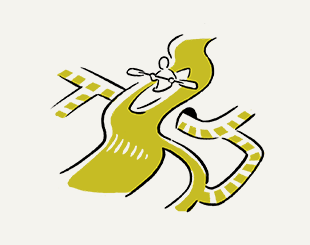
Group 01.
Flow and Physics
Model the “flow” of people and goods, and contribute to a mobility society in which complex transportation networks flow smoothly.
Model the “flow” of people and goods, and contribute to a mobility society in which complex transportation networks flow smoothly.
The “flow” created by self-driving cars and people is the blood that circulates through the body of the mobility society, so to speak. To prevent this flow from becoming stagnant, the Flow and Physics Group is developing mathematical models of the flow, as well as computational methods to guide the flow to its optimum level. Moreover, by using the concept of tensor networks, we aim to construct a revolutionary method that will make calculations overwhelmingly more efficient and eventually be able to handle the traffic flow of an entire city.
Research Outline
Our group is working on the development of new computational methods for various flows, including traffic flow, human flow, and even the movement of cells in living organisms. Our research procedure involves first examining the contents to be computed and then modeling them by incorporating various perspectives, including discrete integrable systems (Box–ball systems). Moreover, the created flow model is put into an algorithm and a computer simulation is performed. By developing a variety of methods to visualize flows, we hope to find a completely new perspective that captures the essence of the mobility society.
Furthermore, if we envision a future society in which self-driving cars are implemented, then it will be necessary to view traffic flow as a network and design an ideal network in which congestion does not occur. Although computing such a complex and huge network as the actual traffic network is challenging at this stage, our group is expecting to solve this problem by using the concept of tensor networks. Data with various indices such as position, time, and velocity are called tensors, and a tensor network is a simpler representation of these tensors in the form of a graph. By handling huge volumes of data in the form of tensor networks, the amount of computation can be greatly compressed.
Our goal is to deepen our knowledge by working on flow models and tensor networks, respectively, and to build a network flow model that can be applied in the future in a mobility society.
Participating Members
| Satoshi Tsujimoto | Graduate School of Informatics, Kyoto University |
| Ryosuke Kojima | Graduate School of Medicine, Kyoto University |
| Kazuki Maeda | Faculty of Informatics, The University of Fukuchiyama |
| Zanlungo Francesco | International Professional University of Technology in Osaka |
| Masashi Iwasaki | Faculty of Life and Environmental Sciences, Kyoto Prefectural University |
| Akiko Fukuda | College of Systems Engineering and Science, Shibaura Institute of Technology |
| Kenji Harada | Graduate School of Informatics, Kyoto University |
| Naoki Kawashima | The Institute for Solid State Physics, The University of Tokyo |
| Tsuyoshi Okubo | Graduate School of Science, The University of Tokyo |
| Daisuke Takahashi | School of Fundamental Science and Engineering, Waseda University |
| Katsuki Kobayashi | Graduate School of Informatics, Kyoto University |
| Julien Gaboriaud | Graduate School of Informatics, Kyoto University |
| Atsushi Maeno | Graduate School of Informatics, Kyoto University |
| Kazuya Okamoto | School of Fundamental Science and Engineering, Waseda University |
| Motokazu Yamashita | Graduate School of Science, Kyoto University |

